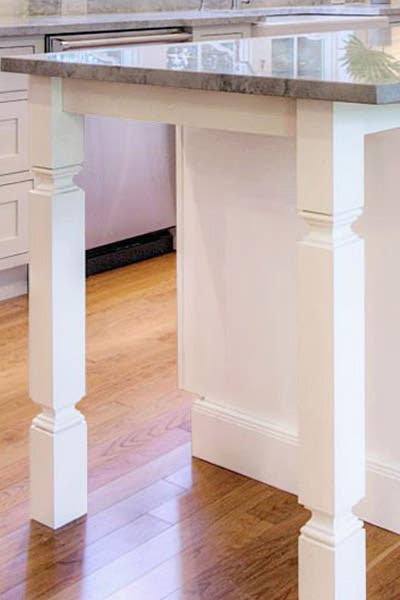Key Factors To Consider for Finding the very best Legs For Cooking Area Island for Your Design
When selecting the suitable legs for your kitchen island, numerous key factors to consider come into play that can dramatically affect both performance and aesthetics. The choice of material, height, and design have to line up with your overall cooking area layout to ensure an unified look.
Determine Your Design Preference
When choosing the ideal legs for your cooking area island,Establishing your design preference is critical. The legs of your cooking area island not just serve a functional objective but additionally contribute substantially to the overall visual of the space. For that reason, recognizing your design style-- be it contemporary, rustic, conventional, or industrial-- is important.
For a contemporary cooking area, consider sleek, minimalistic legs that complement tidy lines and open rooms. Standard kitchens commonly prefer transformed or elaborate legs, which can include a touch of beauty and refinement.
In addition, think about the elevation and proportion of the legs in relationship to the island's surface. Ultimately, your design preference will certainly influence not just the selection of legs yet also the general consistency of your cooking area's design.
Choose the Right Material
Selecting the right material for your cooking area island legs is essential in making sure both sturdiness and visual allure. Different products provide unique advantages, and the option often shows your layout preferences and functional demands.
Timber is a popular option, giving heat and convenience. It can be tarnished or repainted to match your cooking area decor, making it versatile to different designs, from rustic to modern. Wood might call for routine upkeep to protect its appearance and integrity.

If you seek a distinct touch, take into consideration acrylic or glass materials. They can produce an illusion of room and agility in your kitchen, making them an excellent choice for smaller sized areas - Legs For Kitchen Island. Nonetheless, these choices might need mindful handling and upkeep to stay clear of scratches.
Ultimately, the material you select ought to straighten with your kitchen area's overall style, making sure that the legs offer both functional and decorative purposes.
Think About Elevation and Proportions
When developing a cooking area island, elevation and percentages play an essential duty in making certain capability and convenience,. The typical elevation for a kitchen island normally varies from 36 to 42 inches, straightening with conventional counter elevations or bar elevations, respectively. This measurement is vital for integrating with surrounding kitchen counters and stools, making it possible for convenience of use throughout meal preparation and social interactions.
Furthermore, the island's proportions have to enhance the overall kitchen area layout. A well-proportioned island needs to not overwhelm the space; rather, it needs to develop a well balanced visual. Take into consideration the ratio in between the island's size and size, guaranteeing it offers appropriate surface without crowding the cooking area. A basic guideline is to keep a width of 24 to 48 inches, facilitating movement and accessibility.
Moreover, the elevation of the legs or base can influence the visual allure and functionality. Taller legs might lend a more modern-day, ventilated feel, while much shorter ones can evoke a conventional, grounded appearance. Eventually, carefully taking into consideration height and percentages will certainly cause a kitchen area island that is both aesthetically enticing and functionally reliable, improving the general style of the space.
Assess Stability and Sturdiness
A cooking area island's legs should not just match its height and percentages yet additionally supply adequate security and sturdiness to support everyday tasks. The legs are necessary to the overall performance of the island, as they birth the weight of the countertop and any type of added tons, such as appliances or cooking jobs.
When analyzing security, it is critical to think about the leg design check my source and product. As an example, sturdy steel or solid wood legs often offer exceptional strength compared to lighter materials like engineered timber or plastic. Furthermore, a wider base can enhance security, decreasing the threat of wobbling or tipping during use.
Toughness is equally essential; the legs should withstand wear and tear from everyday usage. Take into consideration coatings that shield versus scrapes, dents, and dampness, specifically in a cooking area setting. Moreover, evaluate the high quality of building, such as joints and fastenings, which can substantially affect the legs' long-lasting performance.
Inevitably, purchasing well-crafted legs that focus on security and toughness will certainly guarantee your kitchen area island remains a reliable workspace for many years ahead, enhancing your culinary experiences while keeping visual allure.
Factor in Upkeep and Care
Upkeep and treatment are vital considerations for making sure the durability and performance of kitchen area island legs. When choosing legs, it is vital to examine the materials made use of, as various choices call for varying degrees of upkeep. For circumstances, wood legs might need periodic refinishing or sealing to avoid dampness damage and scratches, while steel legs might require routine brightening to maintain their shine and stop rust.
Additionally, the finish put on the legs can affect maintenance requirements. A high-gloss coating might be much easier to tidy but could reveal scrapes and finger prints quicker than a matte coating. It is a good idea to select products and surfaces that complement your way of life; for instance, if you often host celebrations, select resilient products that can withstand deterioration.
Furthermore, consider the cleaning procedure entailed in maintaining these legs. Smooth surface areas commonly need minimal initiative, while detailed designs might accumulate dirt and grime, necessitating even more labor-intensive cleaning techniques. Legs For Kitchen Island. Eventually, factoring in the upkeep and treatment required for your chosen kitchen area island legs will certainly not just improve their visual allure however additionally guarantee their useful stability gradually
Verdict
To conclude, choosing the ideal legs for a cooking area island demands careful factor to consider of various variables, including layout style, product selection, height, maintenance, and stability. Each component plays a crucial duty in making sure that the legs not only boost the aesthetic allure of the cooking area yet also supply the required assistance and durability for day-to-day usage. A knowledgeable decision will ultimately add to pop over here a useful and visually pleasing site web kitchen area setting.
The legs of your kitchen area island not only offer a useful function however likewise add dramatically to the overall aesthetic of the space.Maintenance and care are critical considerations for making certain the long life and performance of kitchen island legs. Wooden legs may require periodic refinishing or securing to prevent wetness damages and scrapes, while metal legs might need regular polishing to keep their sparkle and avoid corrosion.
Ultimately, factoring in the maintenance and care required for your chosen cooking area island legs will certainly not only improve their visual allure but also guarantee their functional honesty over time.

 Danny Tamberelli Then & Now!
Danny Tamberelli Then & Now! Hallie Eisenberg Then & Now!
Hallie Eisenberg Then & Now! Phoebe Cates Then & Now!
Phoebe Cates Then & Now! Tonya Harding Then & Now!
Tonya Harding Then & Now! The Olsen Twins Then & Now!
The Olsen Twins Then & Now!